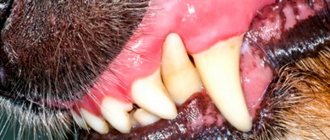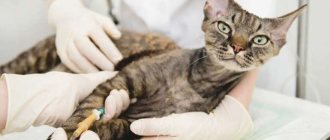Stomatitis in cats is an inflammatory process in the mucous membrane of the animal’s oral cavity. As a rule, stomatitis in cats can occur in chronic and acute forms. The disease is of the following types:
- ulcerative;
- gangrenous;
- autoimmune;
- uremic;
- papillomatous;
- aphthous.
Autoimmune stomatitis
Autoimmune stomatitis develops when one's own immune system rejects its own teeth, identifying them as foreign objects. The cause of this reaction may be a defect in the immune system itself, but most often the reaction occurs due to bacterial plaque on the teeth, which awakens the body's defenses to act decisively.
Causes of stomatitis in cats
1. Low immunity causes inflammation in the oral cavity.
2. Lack of hygiene. Veterinarians recommend brushing your cat's teeth to prevent tooth decay that causes stomatitis. Not everyone decides to do this, so simple hygiene means regularly washing bowls of water and food, and frequent wet cleaning of the room.
3. Unacceptable feed temperature. Cats should not be given cold or hot food. This irritates and injures the protective membrane in the mouth, resulting in inflammation.
4. Injury to the gums and tongue. If a pet eats bones or low-quality food that is too hard, they scratch the oral mucosa. Microbes enter the damage.
5. Infection - if a cat is sick with calcivirus, distemper, etc., ulcers in the mouth are one of the signs of disease.
6. Fungus (candidiasis). Fungi that cause thrush multiply in the mouth due to low immunity and improper functioning of the gastrointestinal tract.
7. Diabetes mellitus or hormonal imbalance lead to the formation of stomatitis.
Papillomatous stomatitis
Papillomatous is caused by a viral pathogen that is transmitted through contact between animals or through contact with their toys, bowls, etc. Unlike the above-mentioned types of diseases, this one is more treatable, since the virus is easily killed by an antibiotic, which only a veterinarian can prescribe. It is prohibited to use so-called folk remedies at home to treat any type of stomatitis, because the consequences of the actions of a non-professional can lead to the death of the pet.
Treatment
Stomatitis brings a lot of discomfort and pain to the cat, so it is necessary to go to the clinic so that the veterinarian can accurately determine the cause of the disease. With secondary stomatitis, treatment takes quite a long time.
Biochemical blood and urine tests and oral culture are required. In severe situations, even surgical treatment, tooth extraction under local or general anesthesia, removal of tartar, etc. are indicated.
For mild forms of the disease, therapy is carried out at home. A thorough examination is necessary; stomatitis may be caused by an object stuck in the mouth.
After eating, you will need to irrigate or rinse your pet's mouth with infusions of herbs: chamomile, oak bark, St. John's wort. It is possible to use local antiseptics, such as Chlorhexidine, Miramistin. You can also use weak solutions of potassium permanganate or hydrogen peroxide, but it is better not to abuse them, otherwise you may injure the mucous membrane even worse.
For small ulcers, you can use special ointments (Actovegin, Mexidol, Levomekol, Cholisal).
A special diet is required. Do not feed your cat dry food or hard foods. It is better to use soft, ground food.
For a bacterial infection, the treatment regimen includes broad-spectrum antibiotics, which will be prescribed by a specialist, because it is important to choose the right dosage and duration of use.
For fungus, antifungal agents are prescribed.
Additionally, painkillers and antipyretics are used.
The doctor will recommend that you strengthen your pet’s immunity and prescribe special supplements and vitamins.
Symptoms of stomatitis
Not every owner can see the signs of the disease in the earliest stages, when its treatment causes practically no difficulty and goes away extremely quickly. Usually people begin to sound the alarm when the disease becomes more severe. At an early stage of development, the following symptoms can be noticed:
- strong increase in thirst;
- salivation is clearly increased;
- careful eating, the cat may chew for a very long time or refuse food altogether;
- bad breath.
If treatment is not started on time, ulcers may form, and the development of gangrene is also possible. In severe form, the disease has the following symptoms:
- usually a complete lack of appetite;
- pronounced swelling on the lips is noticeable;
- the cat is in an extremely depressed state;
- the animal's body temperature rises;
- very bad breath;
- lymph nodes are most often enlarged;
- strong salivation.
Description of the disease
Stomatitis is not a separate disease. This word refers to lesions of the oral mucosa, usually of an inflammatory nature. Depending on the causes, stomatitis in cats can be acute or chronic. As a rule, relapses can be avoided, but in advanced cases, the pet’s quality of life is significantly reduced.
Before treating stomatitis in a cat, the primary or secondary nature of the disease is determined. Insufficient oral care, dehydration, trauma and chemical burns lead to primary stomatitis; secondary develops against the background of infectious and/or chronic diseases.
Diffuse stomatitis in a cat affects the entire oral mucosa.
If inflammation affects a separate area, depending on the location, they speak of a focal form:
- faucitis - inflammation of the palate
- gingivitis - gums
- glossitis - tongue
- palatinite - sky
- Keratitis
Pancreatitis
Eosinophilic granuloma
cheilitis – lips
At risk are unvaccinated, weakened by chronic illnesses, young and old pets. The cause of relapse of the chronic form can be hypothermia, stress, or hormonal imbalances in cats. The veterinarian will determine how to treat stomatitis - you cannot rely on general advice, therapy is individual in each case.
How to treat the disease at home
At home, we carry out the veterinarian's prescriptions and care for the cat.
First aid for a pet
First aid for your pet consists of irrigating the mouth with an antiseptic solution and ensuring that it is examined by a veterinarian.
Treatment regimen depending on the type of stomatitis
Treatment of stomatitis involves a set of measures:
- for all stomatitis, given the aggressive nature of the flora in the cat’s mouth, antibacterial therapy is prescribed: Sinulox;
- Metronidazole;
- Stomorgil;
- Lincomycin;
- aqueous solution of chlorhexidine;
- 1–2% protargol solution;
- Metrogil Denta;
- Tavegil;
- Prednisolone - prescribed systemically in a course of 2 weeks;
- Ketoconazole;
Table: means for the treatment of stomatitis
| A drug | Compound | Operating principle | Price, rubles |
| Sinulox |
| Broad spectrum antibiotic. Do not use during pregnancy or breastfeeding. | 910 |
| Stomorgil |
| Broad spectrum antibiotic with activity against anaerobes. Suitable for pregnant and lactating cats. | 1340 |
| Metrogil Denta | Metronidazole, topical gel | Destroys anaerobic bacteria at the site of application | from 195 |
| Buprenex | Buprenorphine | Analgesic of central action; cats tolerate it well | List A, can only be purchased at a veterinary clinic by dose, the price is low |
| Cyclosporine | Cyclosporine | Immunosuppressant, inhibits the clone of T-lymphocytes, reducing the intensity of the autoimmune reaction | 2500 |
| Prednisolone | Prednisolone, glucocorticoid |
| from 40 |
| Ketoconazole | Ketoconazole | Systemic antifungal drug prescribed for candidiasis | from 121 |
| Katozal |
|
Cannot be used for autoimmune stomatitis | 767 |
Photo gallery: drug therapy for stomatitis in cats
Catozal helps to significantly increase the cat’s body’s resistance to the harmful effects of pathogenic agents.
Miramistin is an antiseptic that prevents the development of microbial flora
Lugol's solution shows excellent disinfectant properties when treating ulcers directly
Metrogyl Denta is an antimicrobial drug in the form of a gel used for infectious and inflammatory diseases of the oral cavity.
Tavegil is an antiallergic drug that helps reduce tissue swelling for stomatitis.
Prednisolone is a hormonal drug that helps quickly relieve inflammation
Sinulox is a broad-spectrum antibiotic
In the treatment of stomatitis, the assistance of a veterinary dental surgeon is often necessary, who carries out:
- for all stomatitis: removal of supragingival and subgingival tartar;
- polishing of tooth crowns;
- application of fluoride, since with stomatitis, tooth enamel is quickly destroyed;
- tooth extraction: with foci of bone tissue resorption in the root zone;
- with broken crowns;
- improperly growing teeth;
- if lymphocytic-plasmacytic stomatitis is resistant to therapy, a decision is made to remove teeth to improve the prognosis: premolars and molars are removed first;
If autoimmune stomatitis is resistant to treatment, molars and premolars are removed to improve its course
The treatment of stomatitis cannot be done without the help of a veterinarian dentist.
Folk remedies for stomatitis
Folk remedies are also used to treat stomatitis:
- Chamomile infusion: pour 15–20 g of dried inflorescences with a glass of boiling water, you can add 4 g of boric acid.
- A decoction of oak bark is the best remedy that has antimicrobial, antiputrefactive, astringent, hemostatic and anti-inflammatory effects:
- Pour a tablespoon of bark into 250 ml of boiling water.
- Boil for another 20 minutes.
- Cool and filter through cheesecloth.
These products are used to irrigate the cat's oral cavity.
Supplementing the treatment regimen with irrigation of the oral cavity with a decoction of oak bark is very useful.
Folk remedies cannot be the only way to treat stomatitis in a pet. They should be considered as adjuvant therapy only.
Rules for medical procedures
If you have stomatitis, you should properly treat your pet’s oral cavity:
- Prepare and place closer:
- herbal decoctions or antiseptic solutions;
- Lugol's solution or protargol;
- syringe or small syringe for washing liquid;
- cotton buds.
- If the cat is aggressive, swaddle him with a towel. As treatment continues, the pet will get better, aggression will decrease, and then it will be possible to do without fixation.
- Wear gloves.
- Open the cat's mouth, tilt his head forward so that he does not swallow the liquid.
- Place the nozzle of a syringe or syringe in the area of one of the corners of the cat’s mouth and inject the washing solution, directing the stream to the gums. The mouth is washed 5–6 times a day with a volume of 5–10 ml, in kittens the volume is less;
- Moisten a cotton swab in a cauterizing solution (Lugol's, protargol), open the mouth again and treat ulcers or erosions. Spot treatment of mucosal defects is performed 3–4 times a day.
- Praise and release the cat.
Video: treatment with Metrogil Denta gel
Caring for a sick animal
When caring for a cat, pay attention to:
- Cat nutrition. Food should be soft, and in severe cases - liquid. Cat food should be lukewarm. It must be offered often, in small portions. After feeding, be sure to wash the mouth. If the cat refuses to eat, the broth is administered using a syringe. If this is not possible for any reason, a nasogastric feeding tube will be placed at your veterinary clinic.
- Availability of water - the pet should drink plenty of clean water at room temperature; dehydration aggravates the course of stomatitis.
- Oral hygiene - at the veterinary clinic, teeth are cleaned and scaled under sedation, after which teeth should be kept clean. Perhaps, with the widespread nature of stomatitis, it is not worth brushing them with a toothbrush, so as not to further injure the mucous membrane, but you can wipe the crowns of the teeth with a gauze cloth to remove soft plaque, which is abundantly formed during stomatitis, both due to the inflammatory process and due to the nutrition of soft tissue. food You also need to remove plaque from the tongue.
- Coat care - you should comb it out; to eliminate the unpleasant odor of the coat, you can use dry shampoo.
- Cleanliness of the bed. You need to lay a disposable diaper on the cat's resting place and change it, as drool will flow on it.
- Anesthetizing a cat - untreated severe pain causes stress and significantly delays recovery time. An analgesic can only be prescribed by a veterinarian.
With stomatitis, the cat is fed only soft and warm food
Prevention
The basic rules of prevention include the following points.
- Regular teeth cleaning. Accustom your pet to this procedure from childhood, then you will not have problems. Pet stores sell special brushes and pastes.
- Check the condition of your pet's oral cavity, then you can notice changes at an early stage and take appropriate measures.
- Make sure you eat properly and drink enough fluids.
- Vaccinate your pet according to age, isolate it from sick animals if necessary.
- Maintain hygiene when feeding. Wash bowls thoroughly and change water.
On our website there are more than 2290 veterinary clinics in Moscow for you on our website biochemical blood test for cats removal of tartar for cats cleaning of teeth for cats blood test for cats











